Adobe Real-Time CDP: Unleashing the Power of Customer Data in Real Time

In today’s high-tech era, businesses gradually move towards digital transformation, making customer data their most valuable asset. Customers, in turn, crave personalized interactions with brands and companies that cater to their unique preferences. Under these circumstances, businesses must collect, analyze, and leverage customer data way more effectively than they used to do before. And Adobe Real-Time CDP is here to help along with other Adobe Experience Cloud Products.
Adobe Real-Time Customer Data Platform is a game-changing tool designed to help businesses unlock the full potential of their customer data. It provides a centralized location for managing, organizing, and activating information in real time. In this article, we dive deep into Adobe Real-Time CDP and explore how it can help you deliver personalized customer experiences, improve marketing ROI, and drive business growth.

Table of contents
- 1 What is CDP?
- 2 What is Adobe Real-Time CDP?
- 3 How Does Adobe Real-Time CDP Work?
- 4 Adobe Real-Time CDP And Its Benefits
- 5 How To Implement Adobe Real-Time CDP?
- 6 Conclusion
- 7 Adobe Real-Time CDP FAQ
- 7.1 What is Adobe Real-Time CDP?
- 7.2 What are Adobe Real-Time CDP key features?
- 7.3 How does Adobe Real-Time CDP compare to other CDPs?
- 7.4 How to implement Adobe Real-Time CDP?
- 7.5 Is Adobe Real-Time CDP suitable for small businesses?
- 7.6 What are the benefits of Adobe Real-Time CDP?
- 7.7 Is Adobe Real-Time CDP compliant with data privacy regulations?
- 7.8 What kind of support does Adobe offer for Adobe Real-Time CDP?
- 7.9 How much does Adobe Real-Time CDP cost?
- 7.10 Is Adobe Real-Time CDP easy to use?
What is CDP?
A CDP is a tool that aggregates customer data into a single database, providing marketing teams with the crucial insights they require to launch a campaign. A CDP’s main goal is to collect data from both online and offline sources to deliver a comprehensive perspective of a consumer. With this information, a CDP system may assist firms in predicting what steps to take with a certain consumer.
Along with that, customer service teams may utilize CDPs to provide more personalized customer assistance. Other application areas include marketing automation and data warehouse solutions.
CDPs are usually divided into several types. Data CDP is the most common system that unifies customer data to produce a single consumer profile. Campaign CDPs, on the other hand, help with campaign management, as well as cross-channel and multichannel marketing hubs. And analytics CDPs are good at analyzing the data they store.
However, it’s important to distinguish CDPs from CRM systems, data warehouses, or data management platforms. CDPs, unlike CRMs, gather numerous types of data from different sources with zero manual maintenance. They also focus on identifying segmented audience profiles, while CRMs are typically managed by salespeople and store customer transaction data.
What is Adobe Real-Time CDP then?
What is Adobe Real-Time CDP?
Like most traditional customer data platforms, Adobe Real-Time CDP lets you work with customer data. However, it has one notable advantage: you receive information right when it appears. To make this happen, Adobe Real-Time CDP relies on the following four pillars:
- Data Collection. The platform collects data from multiple sources, including e-commerce websites, mobile apps, and offline channels.
- Data Unification. Adobe Real-Time CDP unifies customer data collected across different touch points to create a single customer view.
- Real-Time Activation. The platform activates customer data in real time to deliver personalized experiences and modify them across channels right after the new information gets into the system.
- Segmentation. Adobe Real-Time CDP segments your customers based on demographics, behaviors, and other parameters to provide more tailored customer experiences.
These features help Adobe Real-Time CDP create a single, unified view of each customer. With the power of real-time data, you get the ability to create targeted and relevant customer experiences that drive engagement and turn your new clients into loyal customers. Moreover, Adobe’s ability to activate data across various channels results in better marketing ROI and improved customer satisfaction.
How Does Adobe Real-Time CDP Work?
In a nutshell, customer data management in Adobe Real-Time CDP is pretty simple. It consists of ingestion, unification, and activation:
- Ingestion. First of all, Adobe Real-Time CDP consumes data from various sources, including CRM systems, POS, e-commerce websites, mobile apps, and third-party sources. The platform handles large volumes of data, supporting multiple formats.
- Unification. Next, Adobe Real-Time CDP unifies the ingested customer data using various identity resolution techniques. The platform links customer profiles across various data sources to create a single, unified view of each prospect.
- Activation. During the final stage, Adobe Real-Time CDP activates customer data across various channels, including email, web, mobile, and advertising. Thus, it lets you cover all gaps between different marketing strategies while delivering personalized experiences across the entire customer journey.
Adobe Real-Time CDP uses a real-time data processing engine to collect and unify customer data from various sources. It is also worth mentioning that the platform applies machine learning algorithms to these and other processes. For instance, it harnesses the latest technology achievements to analyze customer data and create unified customer profiles.
Once the customer data is collected and unified, you can leverage Adobe Real-Time CDP to activate the ingested information across multiple channels. With the platform’s real-time analytics and reporting capabilities, measuring the impact of your personalized marketing campaigns is a piece of cake.
Now, let’s see how Adobe Real-Time CDP lets you totally re-assemble a customer journey by pulling a holistic customer view. As we’ve already mentioned, the platform provides the ability to integrate and standardize cross-channel data so that you get a single source of truth that combines all touch points (both online and offline). Next, following a particular journey stage, purchase behavior, timing, and user status, Adobe Real-Time CDP creates customer segments that can be tailored when more information is collected.
All the data and insights are accessible to all via intuitive admin experience and simple processes. You get a bunch of instruments that generate a consistent flow of data accessible to your team. First-party tracking across all touchpoints is another notable improvement that makes Adobe Real-Time CDP a valuable asset that delivers privacy-centric identity resolution. The platform ensures that anyone who needs it can master omnichannel data without writing a single line of code.
As for artificial intelligence and machine learning, Adobe Real-Time CDP leverages the latest technologies to estimate how efficient your marketing is across different customer journeys. You can streamline predictive attributes, audiences, and actions to derive additional insights and make informed decisions about your future plans.
Although things may look complicated at the moment, there is nothing to worry about. When you deal with the actual interface for the first time, everything becomes clear. Adobe Real-Time CDP is divided into the following 5 intuitive sections: Profiles, Segments, Identities, Sources, and Destinations.
- Profiles. A profile is a collection of information about an individual or entity that may be used to identify it individually. In this example, the profile is linked to the ECID identity, however, this profile can include additional identities such as an email address or a phone number.
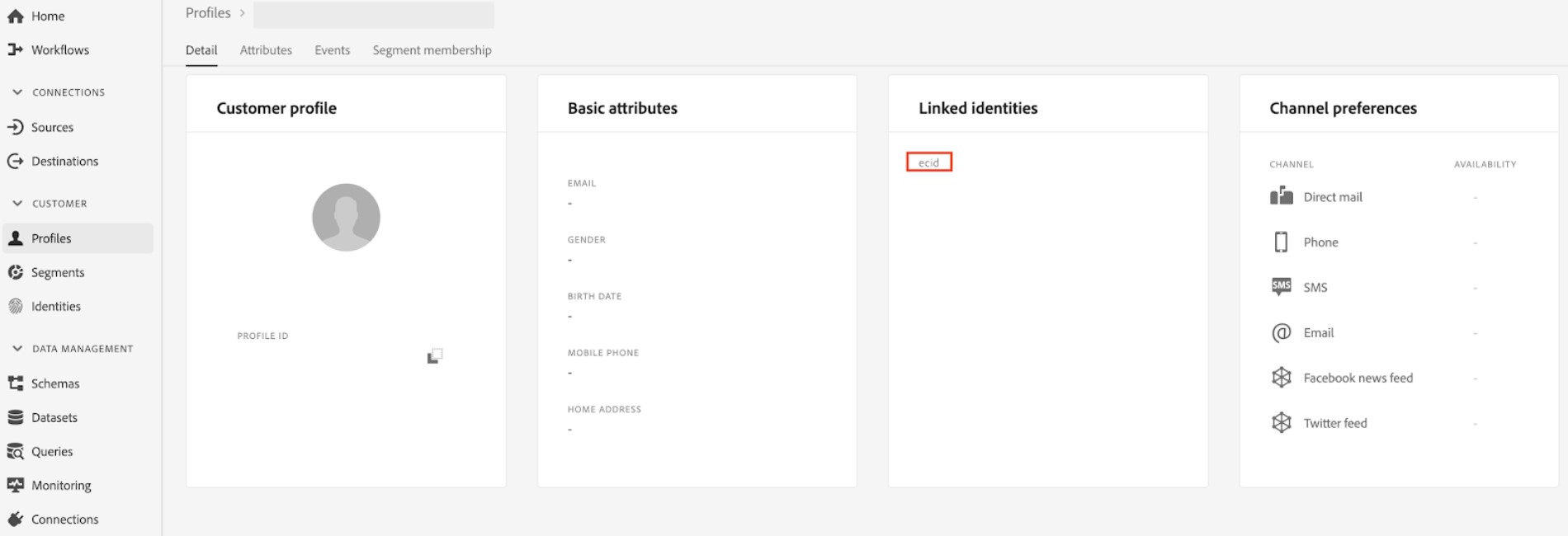
- Segments. With segments, you can split profiles into groups united according to various parameters. Segments in Real-Time CDP are similar to other Adobe products.
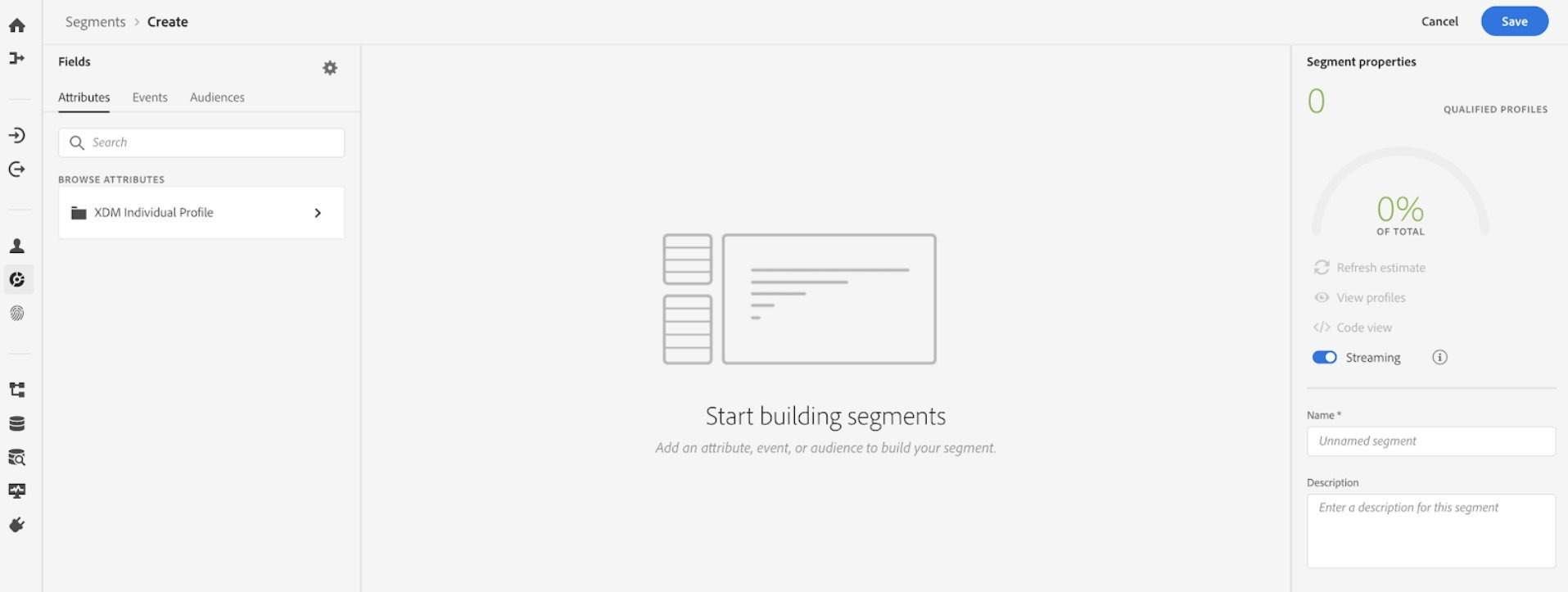
- Identities. The identity page is used for storing identity namespaces with unique information about a person, such as an address, phone number, email, etc.
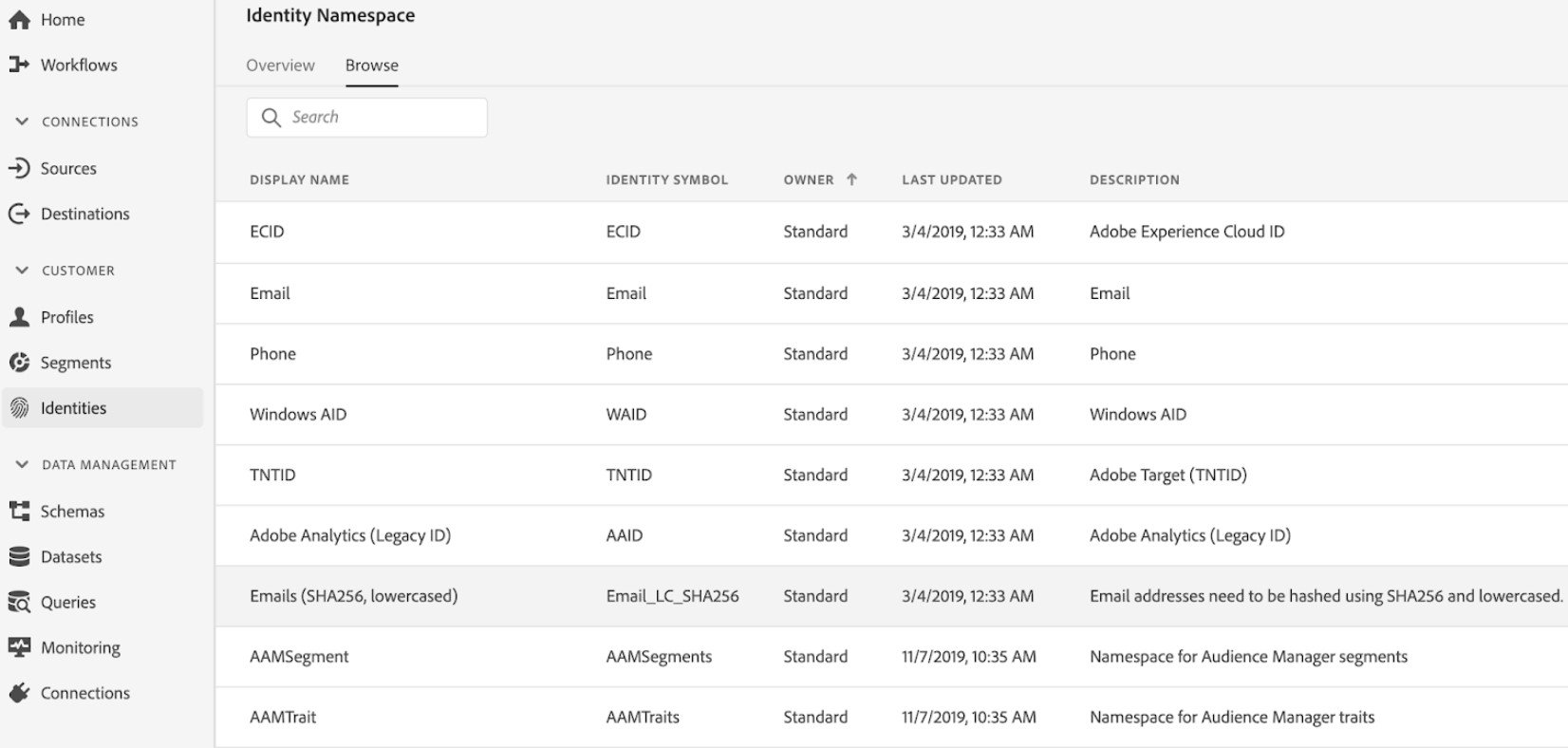
- Sources. In this section, you get a bunch of sources to take data. They are situated under Sources ->Catalog. You can connect other Adobe applications, CRM systems, marketing automation platforms, and other sources to your REal-Time CDP here.
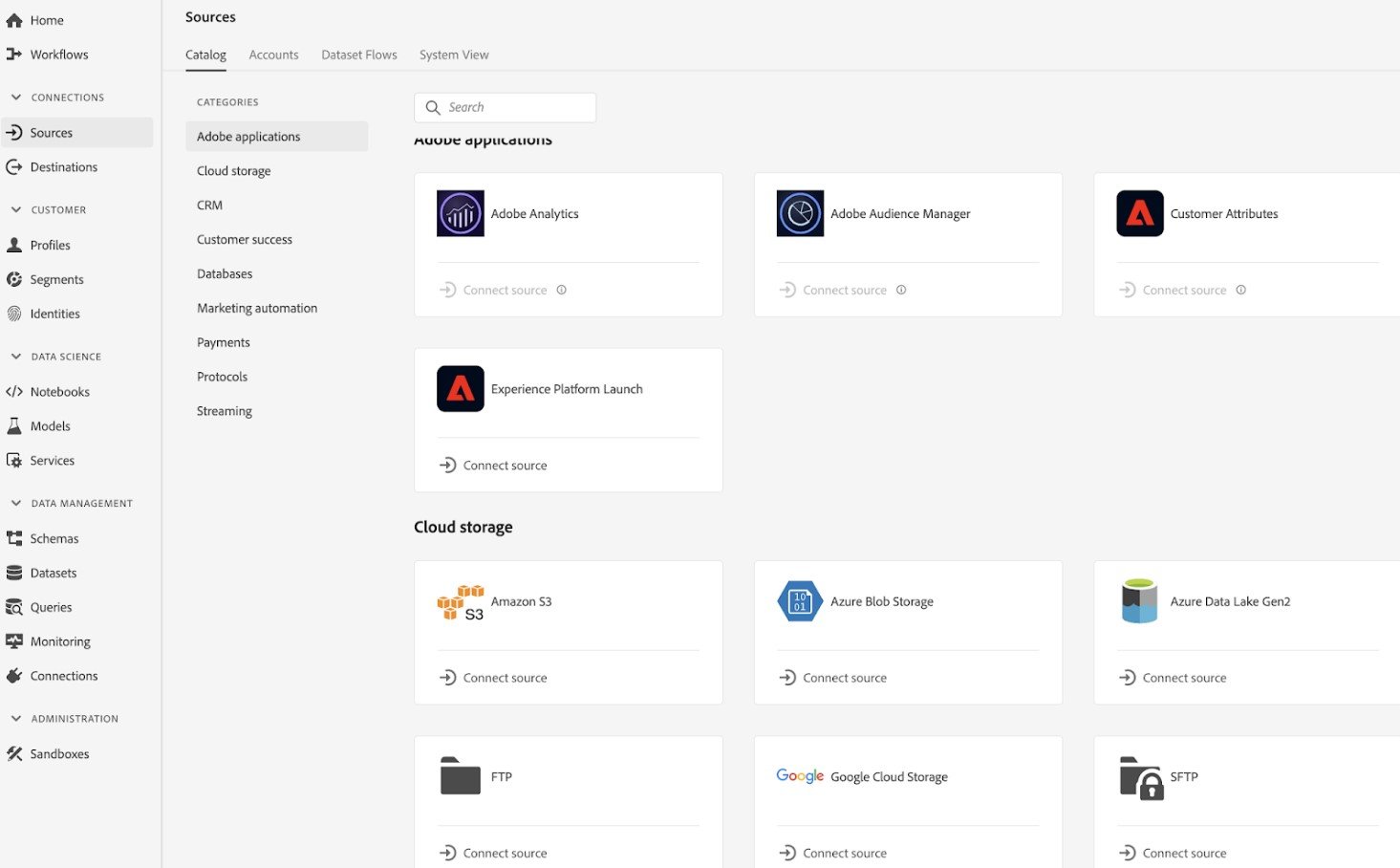
- Destinations. The Destinations section is similar to Sources. You can activate the audiences here and share them with other systems that require detailed customer data. Real-Time CDP lets you either export profiles or segments.
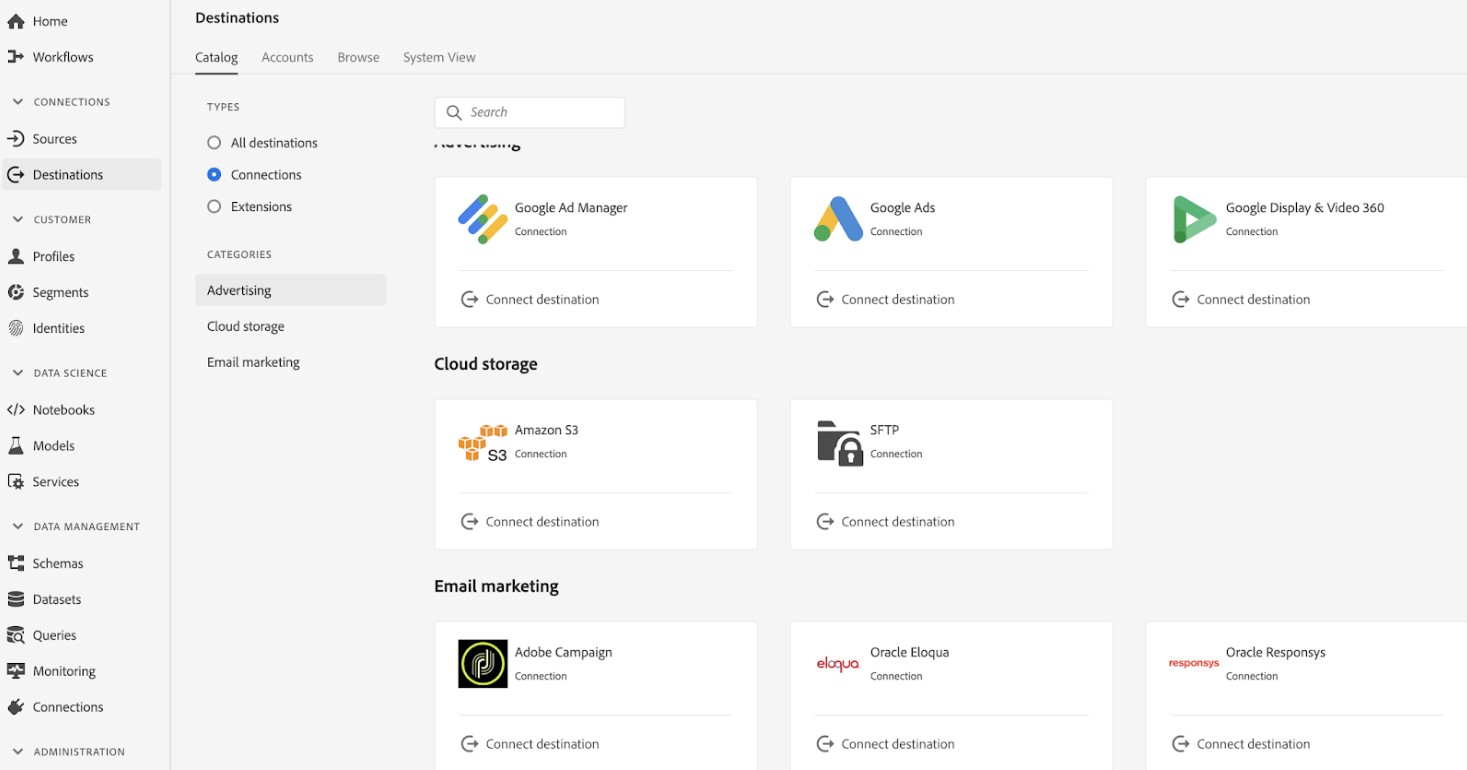
The following visual representation illustrates how profiles are connected to sources and sent to a destination in Adobe Real-Time CDP:
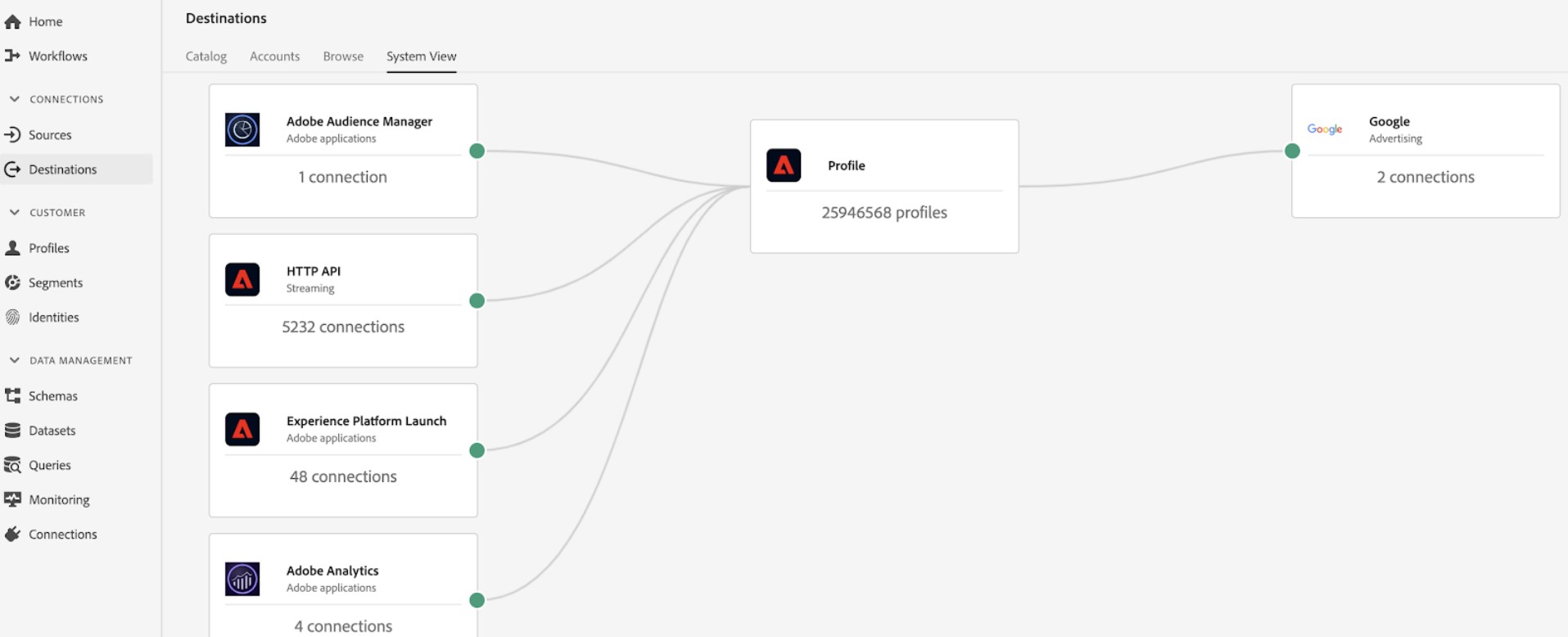
All images were taken from this article: . Also, watch the following video that describes connections in Adobe RT CDP to learn more about the platform:
Adobe Real-Time CDP And Its Benefits
What are the benefits of Adobe Real-Time CDP, you will ask? Well, the platform offers a bunch of strong competitive advantages along with the features represented on competitive platforms. The following Adobe Real-Time CDP benefits are at your disposal:
- Real-Time Insights. Adobe Real-Time CDP provides real-time insights into customer behavior so that you can make data-driven decisions and optimize your marketing strategies.
- Cross-Channel Marketing. The platform collects data across multiple channels, ensuring a consistent and personalized experience across all touchpoints. It employs identity resolution algorithms to connect customer profiles from disparate data sources, resulting in a unified view of each customer.
- Personalization. As we’ve already mentioned, you can harness Adobe Real-Time CDP to reach a new level of personalization. The platform enables businesses to create personalized customer experiences that suit their expectations. The flow of real-time customer data combined across all channels can help you deliver targeted messages that resonate with your clients.
- Improved Customer Satisfaction and Engagement. Adobe Real-Time CDP can help you improve customer satisfaction and engagement. Your clients are more likely to engage with your brand because they are involved in experiences that follow their needs and preferences.
- Improved ROI. All these advantages of Adobe Real-Time CDP can help you improve the ROI of your marketing campaigns, driving revenue growth and profitability.
- Scalability. Adobe Real-Time CDP is a highly scalable solution that can handle large volumes of data. You can start small a grow or leverage the platform as a market giant with thousands of customers across multiple channels.
When it comes to Adobe Real-Time CDP competitors, they include Insider, Klaviyo, Insightly, Bloomreach, Planhat, etc.
How To Implement Adobe Real-Time CDP?
Implementing Adobe Real-Time CDP requires a few simple steps:
- Define Business Objectives: First of all, you need to define your business objectives to determine the key use cases for Adobe Real-Time CDP.
- Identify Data Sources: Next, it is necessary to choose data sources that you want to integrate with Adobe Real-Time CDP.
- Define Data Model: After that, you can define the data model to create a unified view of each customer in Adobe Real-Time CDP. It includes customer attributes, events, and interactions.
- Configure Data Ingestion: Now, it’s a turn for data ingestion. You can leverage APIs, batch processing, or real-time streaming to ingest data from various sources into Adobe Real-Time CDP.
- Configure Data Unification: The next step is related to data unification. You need to configure this process to link customer profiles across various data sources.
- Configure Data Activation: Finally, you can configure data activation. This will activate customer data across various channels.
Adobe Real-Time CDP Industries
You can use Adobe Real-Time CDP across multiple industries. Below, we list the most popular business functions for the platform:
- E-commerce: As an e-commerce merchant, you can use Adobe Real-Time CDP to deliver personalized product recommendations, abandoned cart reminders, and targeted offers. It becomes even more powerful if you use it with Adobe Commerce.
- Financial Services: If you run a financial services company, Adobe Real-Time CDP can help you deliver personalized investment advice, loan offers, and financial planning recommendations.
- Healthcare: When it comes to healthcare, Adobe Real-Time CDP can assist in providing personalized appointment reminders and follow-up care instructions.
- Travel: Adobe Real-Time CDP for the travel industry can help companies deliver personalized travel recommendations, loyalty offers, and real-time flight updates.
- Retail: If you are a retailer, leverage Adobe Real-Time CDP to deliver personalized promotions, product recommendations, and in-store experiences.
- Marketing: Adobe Real-Time CDP can help marketing teams by delivering real-time insights into customer behavior. As a result, it enables them to optimize campaigns with more personalized experiences.
- Customer Service: Customer service teams can utilize Adobe Real-Time CDP to offer personalized support and recommendations, improving customer satisfaction and retention.
Note that these are just a few industries where Adobe Real-Time CDP can be used.
Adobe Real-Time CDP Use Cases
Now, let’s take a look at a few Adobe Real-Time CDP use cases mentioned above:
- Personalized Product Recommendations: Let’s assume that you work in clothing retail. You can use Adobe Real-Time CDP to collect customer data and deliver personalized product recommendations based on their past purchases, browsing history, and preferences.
- Abandoned Cart Reminders: If your business is represented by an e-commerce website, use Adobe Real-Time CDP to send personalized abandoned cart reminders.
- Loyalty Offers: At the same time, you can utilize Adobe Real-Time CDP to deliver loyalty offers to customers who frequently purchase from your brand. It can work for different industries.
- Real-Time Marketing Campaigns: As a marketer, use Adobe Real-Time CDP to adjust your marketing campaigns in real time. You will be able to deliver personalized messages and offers based on customer behavior and preferences that can frequently change.
- Personalized Healthcare Reminders: If you are a healthcare provider, use Adobe Real-Time CDP to deliver personalized reminders to patients based on their medical history and preferences. Furthermore, you can even use this information to offer personalized health recommendations.
Adobe Real-Time CDP Examples
As we’ve already mentioned, Real-Time CDP perfectly works with other Adobe Experience Cloud products, such as Customer Journey Analytics. Let’s take a look at customer re-engagement that involves both tools.
It’s impossible to determine when clients leave without a thorough perspective of the customer journey. The problem is that the actions your prospects take before leaving the party are unclear. With Adobe, you can use Customer Journey Analytics to achieve better clarity. The platform lets you apply filters to flow and fallout graphs to dig down into different pathways associated with your customers.
Then, you may determine the experiences missed by comparing the behaviors of a lapsed audience to the behaviors of a devoted audience. Once an audience has been recognized as a strong prospect for re-engagement, send them to Real-Time CDP to activate in the appropriate channels where they face win-back experiences.
Depending on the sort of transaction your consumers are searching for, customer journeys might be fairly extensive. With elongated purchase cycles, it can be difficult to comprehend all of the cross-channel touchpoints involved in the decision-making process, as well as where clients get stuck. However, combining your online and offline data provides a holistic perspective.
It means that you can start picking apart journeys to locate those sticking areas that should be improved. With Real-Time CDP and Customer Journey Analytics, you can discover such points and re-organize customer journeys with proven experiences using AI, machine learning, an easy-to-use drag-and-drop interface, and rich visualizations.
When you examine conversion rates, these tools let you do that in numerous ways. Consequently, you may gain a deeper understanding of what your strong and weak points are, enhancing the experience across all touchpoints.
Let’s suppose you run an e-commerce website that sells plants. You want to boost customer engagement and profitability by providing tailored experiences to your consumers.
To begin, you can incorporate Adobe Real-Time CDP into your online store to collect client activity data such as browsing history, purchase history, and preferences. Adobe Real-Time CDP then unifies and processes this information to generate a full customer profile for each individual buyer.
You may then use this data to provide customized product suggestions to clients based on their previous purchases and browsing behavior. If a consumer has previously purchased a succulent, for example, you might suggest additional plants that will match that purchase, such as another succulent or cactus.
Moreover, Adobe Real-Time CDP may be used to send abandoned cart notifications to clients who leave things in their shopping cart but do not complete their transactions. You may urge consumers to complete their purchases and enhance your conversion rate by sending a customized message that contains the particular products remaining in the basket.
Additionally, you may develop loyalty programs, such as discounts or special access to new items, for clients who often purchase with your company. Adobe Real-Time CDP may assist you in identifying these clients and delivering targeted offers that will encourage them to continue purchasing from your company.
Let’s be more specific, exploring the case of The Home Depot. The company utilized Real-Time CDP and Customer Journey Analytics to create a unified customer experience online and in stores. With an objective to redefine the overall customer experience, they implemented a customer-based strategy focused on specific journeys.
The company created unified customer profiles using data from multiple sources, including website activity, in-store sales, call center data, etc. This information was enough to divide high-value customers into hundreds of unique segments associated with specific journeys.
Furthermore, the combination of Real-Time CDP and Customer Journey Analytics helped to understand how customers engaged before making a purchase. This observation uncovered the most impactful touchpoints in the entire customer journey.
As a result, The Home Depot optimized both marketing and personalization efforts to suggest in-store locations and relevant products. It resulted in much faster delivery of personalized experiences (up to 10 times), a substantial increase in personalized campaigns (62%), and a significant growth of online orders picked up in-store (55%).
Conclusion
As you can see, Adobe Real-Time CDP may assist you in providing tailored experiences to your clients. If you looking for a tool to enhance engagement and profitability, choose this platform with no doubt. It will help you construct a full client profile that combines information from numerous sources. Next, you can utilize this data to make tailored suggestions, reminders, and offers that keep your consumers coming back.
Another excellent thing is that the platform suits a variety of sectors, including e-commerce, healthcare, finances, etc. No matter where your business operates, Adobe Real-Time CDP can help you get the most in-depth insights.
Thus, it is a must-have tool for businesses trying to stay competitive in today’s digital era. Thanks to its robust data processing engine, machine learning algorithms, and real-time analytics capabilities, companies can not only stay afloat but also move forward, leaving their competitors behind.
Adobe Real-Time CDP FAQ
What is Adobe Real-Time CDP?
Adobe Real-Time CDP is a customer data platform designed to unify customer data from various sources in order to create a unified customer view. As its user, you can leverage Real-Time CDP to understand each customer’s preferences, behavior, and history and deliver personalized experiences.
What are Adobe Real-Time CDP key features?
Real-time data access, unified customer profiles, activation across various channels, and scalability are among the key Adobe Real-Time CDP features.
How does Adobe Real-Time CDP compare to other CDPs?
In comparison with other CDPs, Adobe Real-Time CDP offers several advantages, including real-time data access, support for multiple channels, and scalability.
How to implement Adobe Real-Time CDP?
Implementing Adobe Real-Time CDP consists of these steps:
– define business objectives,
– identify data sources,
– define the data model,
– configure data ingestion, data unification, and data activation.
Is Adobe Real-Time CDP suitable for small businesses?
Yes, it is. Adobe Real-Time CDP is suitable for businesses of all sizes. Its outstanding scalability provides the ability to handle large volumes of data, so you can start small and grow.
What are the benefits of Adobe Real-Time CDP?
Using Adobe Real-Time CDP is associated with such benefits as improved customer engagement, increased marketing ROI, business growth, and better-personalized experiences.
Is Adobe Real-Time CDP compliant with data privacy regulations?
If you are afraid of issues associated with data privacy regulations, there is no reason to worry because Adobe Real-Time CDP is compliant with data privacy regulations such as GDPR and CCPA. The platform provides features such as data consent management, deletion, and access requests to ensure compliance with major standards.
What kind of support does Adobe offer for Adobe Real-Time CDP?
Adobe offers various support options for Adobe Real-Time CDP, including technical support, training, and consulting services. In addition to that, you can find a knowledge base, community forums, and documentation to get started.
How much does Adobe Real-Time CDP cost?
The cost of Adobe Real-Time CDP depends on various factors such as the number of data sources, the volume of data, and the level of support required. Contact Adobe for pricing details.
Is Adobe Real-Time CDP easy to use?
Since Adobe Real-Time CDP comes with a user-friendly interface, it is easy to use. The platform also provides various pre-built integrations and templates to help businesses get started quickly.









